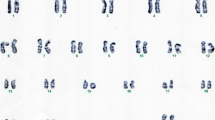Summary
A study of the ring chromosome 13 syndrome is presented with detailed clinical and cytogenetic features of three new unrelated cases. The clinical limits of this syndrome can now be defined. An analysis of these cases together with those in the literature indicates that the syndrome forms a continuous spectrum, and no further taxonomic subdivision is possible at this stage of knowledge. The chromosome breakpoints in the first two cases are 13p11 and 13q32 and in the third case 13p11 and 13q33 or 13q34. All described cases of the ring 13 syndrome have breakpoints within the region bounded by bands 13q21 to 13q34. All rings are negative for silver banding. Peripheral blood cultures showed an average of 88% of metaphases to be 46.XX,r(13), with the remaining 12% manifesting either random loss or ring duplication. The rings vary in size and show a variable number of centromeres. An estimate of the birth incidence of this condition in the Anglo-Saxon population is 1 in 58,000. Parents of affected children are clincally and cytogenetically normal, the rings in affected offspring being meiotic in origin.
Similar content being viewed by others
References
Biles RR, Luers T, Sperling K (1970) Case report, D1 ring chromosome in newborn with peculiar face, polydactyly, imperforate anus, arrhinencephaly, and other malformations. J Med Genet 7:399–401
Carnevale A, Blanco B, Castillo J, Castilla V del, Dominguez D (1979) A child with minimal abnormalities. Am J Med Genet 4:271–277
Cuschieri A, Agius PV, Scheres JMJC (1977) Partial deletion of the long arm of chromosome No. 13. Hum Genet 36:341–344
Emanuel BS, Zackai EH, Moreau L, Coates P, Orrechio E (1979) Interstitial deletion 13q33 resulting from maternal insertional translocation. Clin Genet 16:340–346
Funderburk SL, Sparkes RS, Klisak I (1979) Phenotypic variation in two patients with a ring chromosome 22. Clin Genet 16:305–310
Grace E, Drennan J, Colver D, Gordon RR (1971) The 13q-deletion syndrome. J Med Genet 8:351–357
Hoo JJ, Obermann U, Cramer H (1974) The behaviour of ring chromosome 13. Humangenetik 24:161–171
Howard-Peebles PN (1977) Indications for chromosome analysis illustrated by a case of ring 22. J Hered 68:268–269
Kistenmacher ML, Punnett HH (1976) Comparative behaviour of ring chromosomes. Am J Hum Genet 22:304–318
Ledbetter DH, Riccardi VM, Au WW, Wilson DP, Holmquist GP (1980) Ring chromosome 15: phenotype, Ag-NOR analysis, secondary aneuploidy, and associated chromosome instability. Cytogenet Cell Genet 27:11–122
Lejeune J, Lafourcade J, Berger R, Cruveiller J, Rethoré M-O, Dutrillaux B, Abonyi D, Jérôme H (1968) Le phénotype (Dr). Etude de trois cas de chromosomes D en anneau. Ann Genet (Paris) 11:79–87
McClintock B (1938) The production of homozygous deficient tissues with mutant characteristics by means of the aberrant mitotic behaviour of ring-shaped chromosomes. Genetics 23:315–376
McDermott A, Voyce MA Romain D (1977) Ring chromosome 4. J Med Genet 14:228–231
Niebuhr R (1977) Partial trisomies and deletions of chromosome 13. In: Yunis JJ (ed) New chromosomal syndromes. Academic Press, New York
Niebuhr E, Ottosen J (1973) Ring chromosome D (13) associated with multiple congenital malformations. Ann Genet (Paris) 16:157–166
Schmid M, Henrichs I, Nestler H, Knorrgartner H, Teller WM, Krone W (1978) Analysis of banding patterns and mosaic configurations in a case of ring chromosome 15. Hum Genet 41:289–299
Schwarz D (1958) On the stabilization of a ring chromosome in maize. Genetics 43:86–91
Scribanu N, McCullars EB, Baumiller RC, Colon AR (1980) The syndrome of ring chromosome 12. Am J Med Genet 5:165–170
Telfer MA, Clark CE, Casey PA, Cowell HR, Stroud HH (1980) Long arm deletion of chromosome 13 with exclusion of esterase D from 13q32 to 13qter. Clin Genet 17:428–432
Tsukino R, Tsuda N, Dezawa T, Ishii T, Koike M (1980) Ring chromosome 10: 46,XX,r(10)(p15-q26). J Med Genet 17:148–151
Verma RS, Dosik H, Chowdhry IH, Jhaveri RC (1978) Ring chromosome 13 in a child with minor dysmorphic features. Irregular phenotypic expression of ring 13 syndrome. Am J Dis Child 132:1018–1021
Wang H-C, Melnyk J, McDonald LT, Uchida IA (1962) Ring chromosomes in human beings. Nature 195:733–734
Zuffardi O, Danesino C, Poloni L, Pavesi F, Bianchi C, Gargantini L (1980) Ring chromosome 12 and latent centromeres. Cytogenet Cell Genet 28:151–157
Author information
Authors and Affiliations
Rights and permissions
About this article
Cite this article
Martin, N.J., Harvey, P.J. & Pearn, J.H. The ring chromosome 13 syndrome. Hum Genet 61, 18–23 (1982). https://doi.org/10.1007/BF00291324
Received:
Revised:
Issue Date:
DOI: https://doi.org/10.1007/BF00291324




